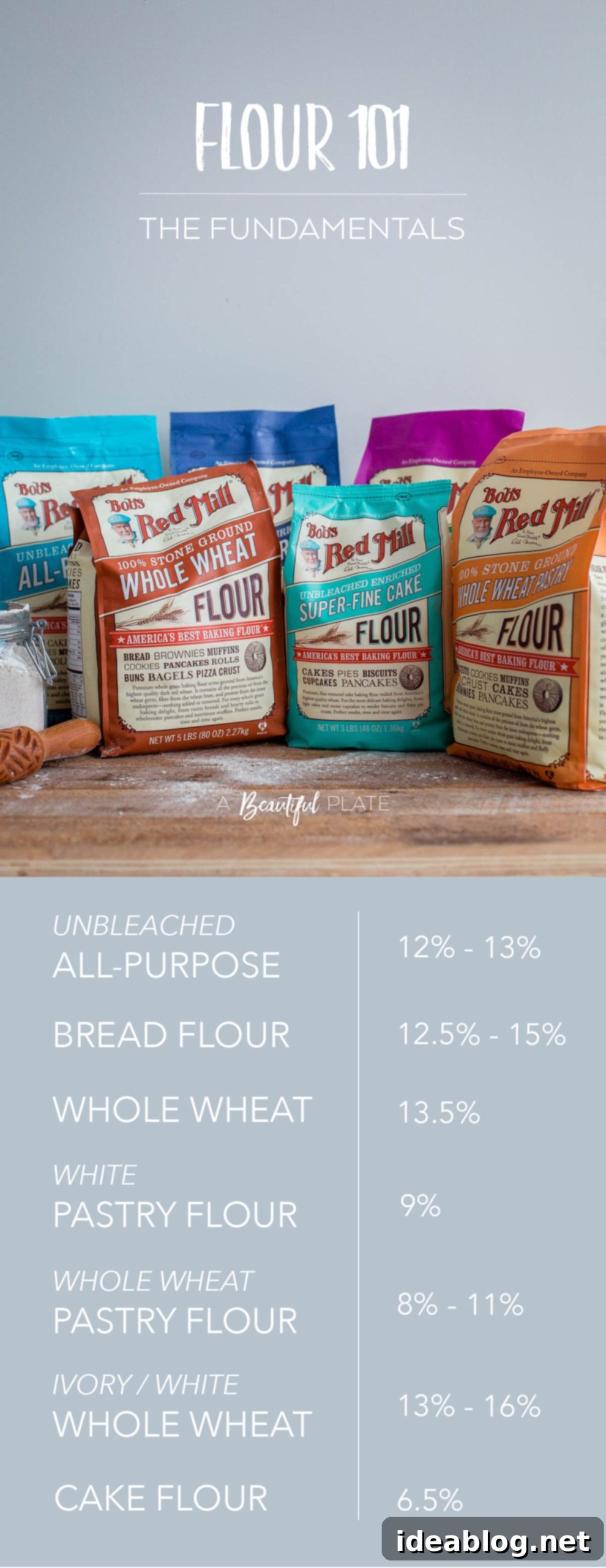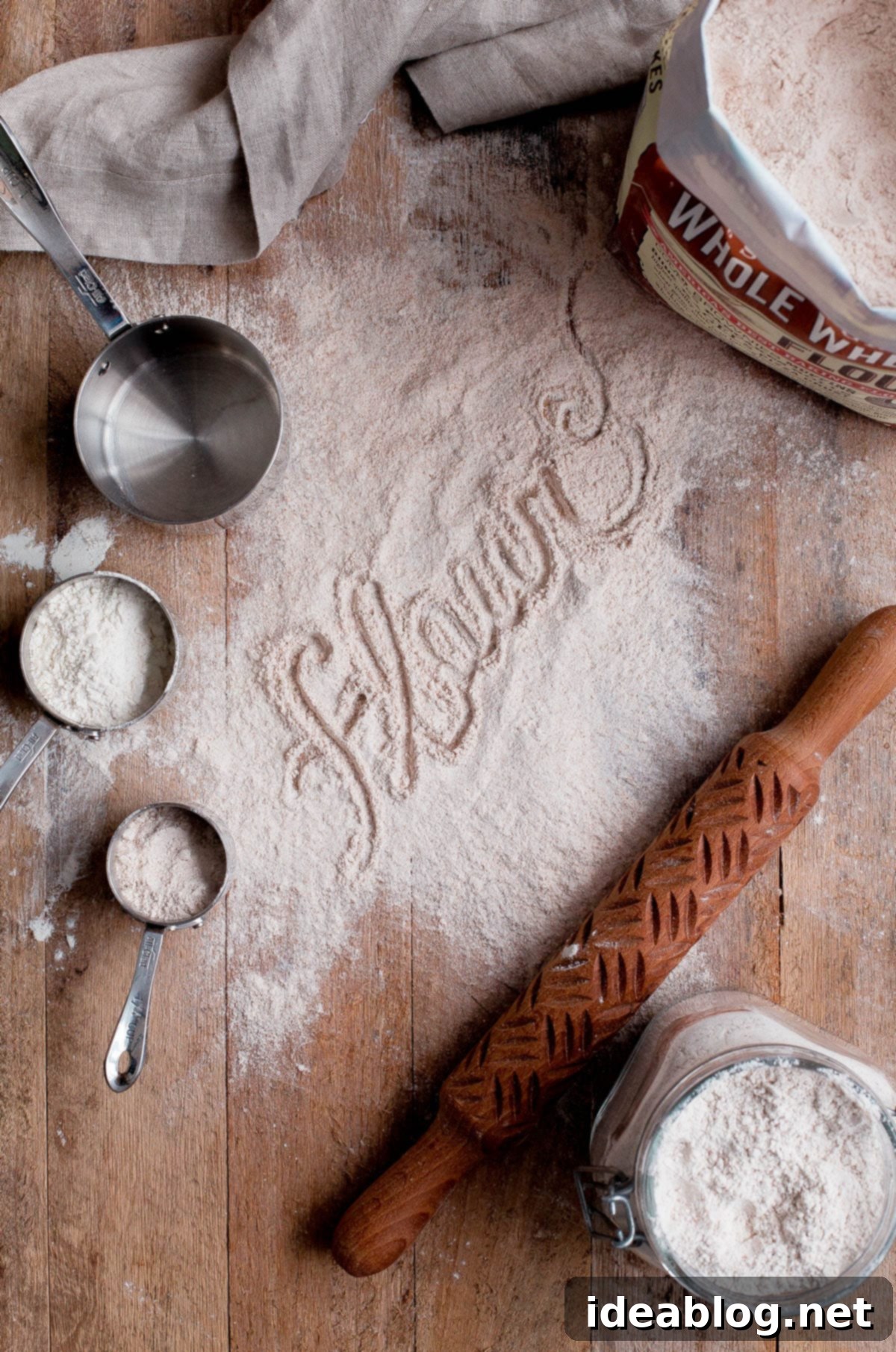The Ultimate Guide to Baking Flour: Understanding Types, Uses, and Gluten Science for Perfect Results
Embark on a fascinating journey into the world of baking flour, where we uncover the fundamental differences between various types and explore when and why to use them for culinary perfection. This approachable guide delves into the science behind flour, empowering you to make informed choices for every baking adventure.
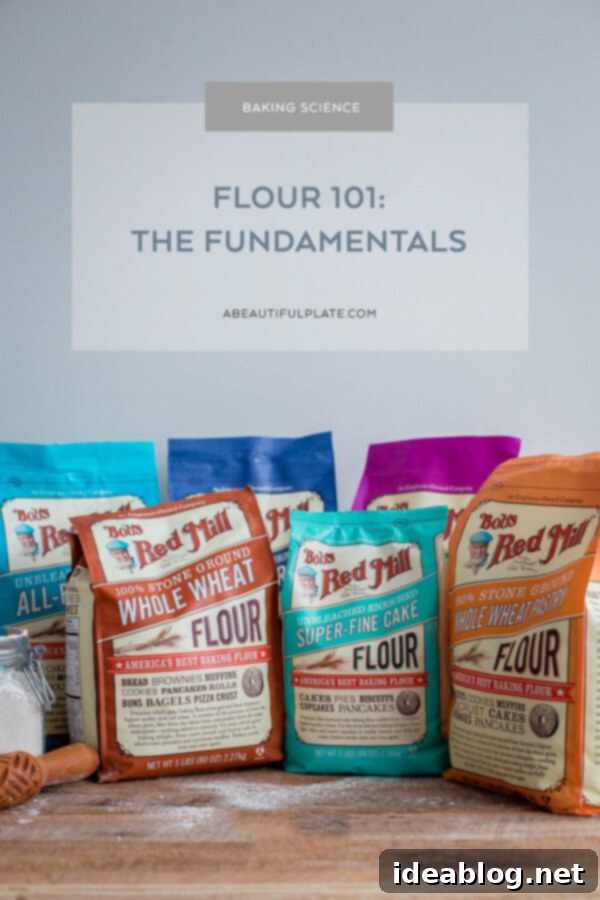
Welcome to a comprehensive exploration of flour, the foundational ingredient in countless baked goods. Today, we’re diving deep into the diverse world of wheat flours, covering everything from everyday all-purpose varieties to specialized types like cake and bread flour. For any baker, whether novice or expert, understanding the nuances of each flour—when to use it, why it performs differently, and how it interacts with other ingredients—is a game-changer. This guide aims to demystify the science of baking flour, providing you with the essential knowledge to consistently achieve delicious and desired results.
While this article might lean a bit into the “nerdy” and technical aspects, much like our previous deep dive into cooking salts, we firmly believe that grasping the whys and hows of baking is incredibly empowering and rewarding. Our focus will be on baking flour varieties derived from various strains of wheat, all of which are commonly found in most grocery stores. By the time you finish reading, you’ll be able to confidently distinguish between bread flour and all-purpose, appreciate the unique qualities of pastry flour, and understand the secret behind cake flour’s ability to create light-as-air sponge cakes. Prepare yourself for an incredibly informative post that promises to elevate your baking prowess.
Let’s begin our journey into the essential world of baking flour…
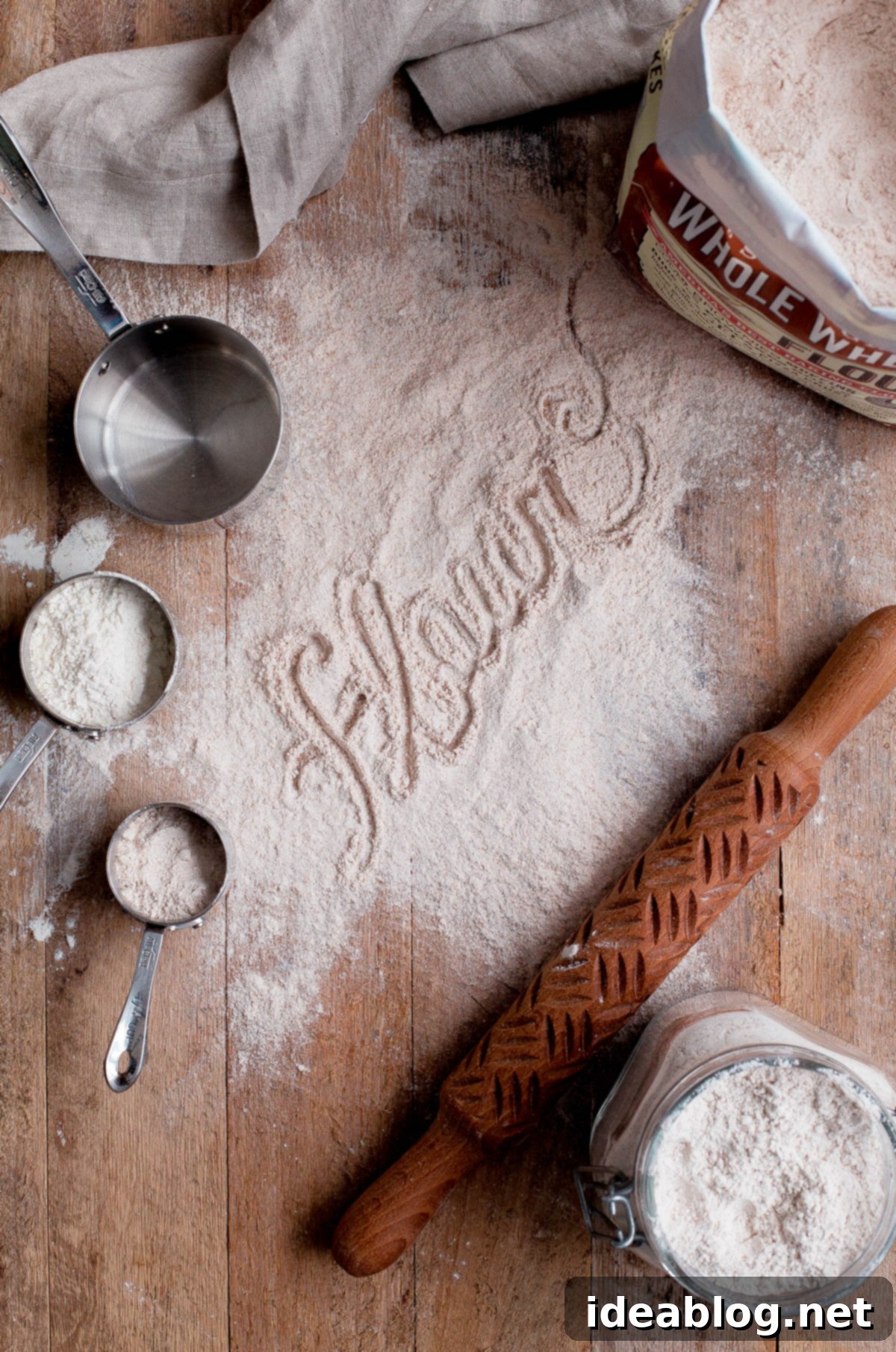
The Foundation: Understanding Wheat and Its Components
At the core of most baking flours is the wheat kernel, also known as a wheat berry—the very same grains you might encounter in the bulk bins of your grocery store. Wheat flours are meticulously produced by milling these kernels, which originate from various strains of wheat. In my own kitchen, I consistently rely on Bob’s Red Mill flours due to their unwavering quality and consistency (you can read more about my choice here). The gluten percentages and milling specifications discussed in this guide generally align with their brand, serving as a reliable reference point, though minor variations can occur across different manufacturers. It’s also worth noting that as flours undergo natural aging, their gluten and protein content can subtly increase, further enhancing desirable baking characteristics over time.
Each wheat kernel is a sophisticated structure composed of three fundamental parts:
- Germ: This is the embryonic part of the kernel, packed with natural oils, B vitamins, and essential minerals. It’s the life-giving component from which a new wheat plant would sprout.
- Bran: The hard, protective outer layer of the kernel, rich in dietary fiber, antioxidants, and trace minerals. It contributes significantly to the texture, color, and nutritional profile of whole grain products.
- Endosperm: The largest component, comprising about 83% of the kernel’s weight. It primarily consists of starch molecules and protein, serving as the main food supply for the germ during germination. This is the part almost exclusively used to produce refined white flours.
The distinction between refined and whole wheat flours lies in the milling process. All-purpose flours and most other refined flours are produced solely from the endosperm. During milling, the germ and bran are carefully separated and removed. The remaining endosperm is then ground into fine particles, known as “streams,” which are analyzed for their precise protein and starch content. This allows millers to create specific flour blends tailored for certain baking characteristics, ensuring consistent performance. Stone-ground flours are a notable exception, as their traditional milling method can inadvertently retain some of the germ and bran, even in what is considered a more refined product, lending them a unique character.
In contrast, whole wheat flours are produced by milling the entire wheat kernel—germ, bran, and endosperm—together. This “whole grain” approach ensures that whole wheat flours generally possess a higher protein content than refined all-purpose flours. The inclusion of all three parts also imparts a darker color, a more robust, nutty flavor, and a significantly superior nutritional profile, being rich in fiber, vitamins, and minerals. This comprehensive milling process is what makes whole wheat flour a distinct and highly valued ingredient for both its health benefits and its unique contribution to flavor and texture in baking.
The Magic of Gluten: Structure, Elasticity, and Baking Results
Gluten, often a subject of discussion, is fundamentally a term for the specific proteins—glutenins and gliadins—naturally present in wheat. In their dry, dormant state, these wheat proteins have very little inherent structure. However, a remarkable transformation begins when flour is combined with water. The gluten proteins absorb the liquid, change their conformation, and begin to form intricate bonds with one another. This bonding process creates a tightly coiled yet highly elastic network, which can be visualized as a sophisticated, interconnected series of Slinky toys.
This “slinky-like” characteristic is the essence of gluten’s power in baking. These protein structures possess an extraordinary ability to stretch and expand significantly, providing both remarkable elasticity and structural integrity to doughs and batters. As they stretch, they create a framework that can hold gases (like carbon dioxide produced by yeast), allowing baked goods to rise and maintain their shape. This unique property of gluten is what enables us to create everything from airy, voluminous artisan breads with large, irregular air pockets to perfectly chewy al dente pasta strands, and even delicate, paper-thin sheets of puff pastry that can withstand extensive rolling without tearing or crumbling. The development and skillful manipulation of this gluten network are central to achieving desired textures in a vast range of baked goods.
An Important Nuance: Whole Wheat Flour and Gluten Strength: While whole wheat flours are indeed high in protein and thus contain a significant amount of gluten, they typically produce weaker gluten strands compared to their refined counterparts. This is due to the presence of the bran and germ. The sharp, abrasive particles of the bran can physically disrupt the formation of continuous gluten networks, essentially acting like tiny razors that “cut” the developing protein strands. This interference prevents the gluten from achieving its full elastic potential, which is why baked goods made with 100% whole wheat flour often exhibit a denser, more compact structure with less overall rise and airiness. Special techniques are often required to overcome this challenge and coax a lighter texture from whole wheat doughs.
The development of gluten is also heavily influenced by hydration and mechanical manipulation. When flour and water are mixed, and the mixture is then worked, stretched, or kneaded (as with bread dough), the gluten proteins become fully hydrated, align, and form progressively stronger, more elastic bonds. This process not only intensifies the gluten concentration but also enhances its ability to stretch and trap air. Conversely, minimal working or mixing results in less concentrated and less developed gluten. This principle dictates that certain baking applications benefit greatly from robust gluten development (e.g., yeast-leavened breads, pizza doughs, pasta, laminated pastries), while others necessitate minimal gluten formation to achieve a tender crumb (e.g., pancakes, quick breads, cakes leavened with chemical leaveners, tender pie doughs).
Furthermore, other ingredients in your recipe can significantly impact gluten strength. Understanding these interactions is crucial for mastering techniques and developing successful recipes. For instance, the ions in salt tend to strengthen gluten networks, leading to a firmer, more resilient dough that is easier to handle. In contrast, larger quantities of sugar and fat, common in sweet pastries and rich cakes, actively work to decrease overall gluten strength. Sugar competes with flour for water, inhibiting gluten hydration, while fat coats the gluten strands, preventing them from bonding effectively. Acidity can also weaken gluten structures, which is why some pastry dough recipes might incorporate a touch of vinegar or lemon juice; this helps tenderize the dough by subtly breaking down the gluten network, preventing toughness.
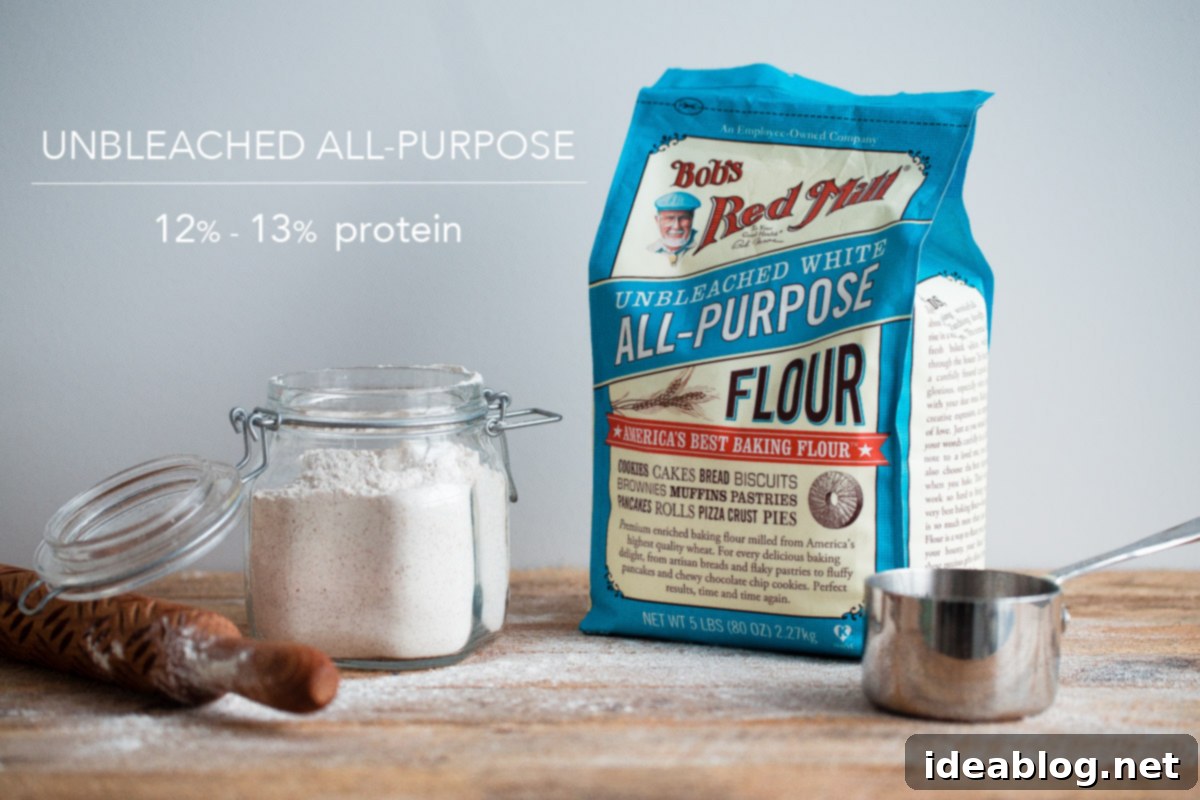
Exploring Different Types of Baking Flour & Their Ideal Applications
The wide variety of baking flours available is a direct consequence of different wheat strains possessing varying protein levels, which in turn dictates their gluten-forming potential. For example, hard red winter wheat naturally contains more protein than soft white wheat, and these differences guide the production of flours tailored for specific baking tasks. Below, we’ll examine common flour types, their typical protein ranges (based on Bob’s Red Mill specifications for consistency), and their best uses. Bob’s Red Mill meticulously sets these protein thresholds and uses them to test every shipment of wheat, ensuring remarkable reliability from bag to bag—a critical factor for consistent baking success.
Unbleached All-Purpose Flour (12% – 13% Protein)
Often regarded as the “workhorse” or “default” flour in the kitchen, unbleached all-purpose flour is exceptionally versatile. Unless a recipe specifies a different type, it’s generally safe to assume that all-purpose flour is the intended ingredient. It’s crucial to remember, however, that the protein content of all-purpose flour can vary considerably by country and region, which directly impacts baking outcomes. In the United States, it typically features a mid-level protein content, providing a balanced performance.
This flour is primarily milled from hard red winter wheat. As a refined flour, the bran and germ are removed during processing, resulting in a clean, light-colored flour. Its moderate protein content offers a good balance of strength and tenderness, making it suitable for a vast array of baking applications. From cookies, muffins, and quick breads to pie crusts and even some lighter, tender yeast doughs, all-purpose flour provides reliable results, offering enough gluten for structure without making items overly chewy.
Bleached All-Purpose Flour vs. Unbleached All-Purpose Flour:
The key difference between bleached and unbleached flours lies in their treatment. Bleached flours undergo chemical processing with agents like benzoyl peroxide or chlorine dioxide. These chemicals rapidly whiten the flour and accelerate its aging process, which traditionally improved its baking qualities. Some bleached flours may also contain bromate, a dough conditioner intended to enhance rise and elasticity; however, it’s notable that bromate is prohibited in many countries outside the United States due to health concerns (learn more here).
As a side effect of the chemical bleaching process, bleached all-purpose flours generally have a slightly lower protein content than their unbleached counterparts. This lower protein can sometimes be desirable for exceptionally delicate, flaky baked goods, as less protein often leads to greater tenderness. Personally, I rarely, if ever, opt for bleached flours, preferring more natural alternatives.
In contrast, high-quality brands like Bob’s Red Mill ensure their unbleached flours are entirely chemical-free. They achieve similar beneficial baking effects, such as improved rise and elasticity, by naturally incorporating a small amount of malted barley flour into their all-purpose blends. This natural enzymatic process enhances baking performance without the need for harsh chemicals, providing a purer product for your culinary creations.
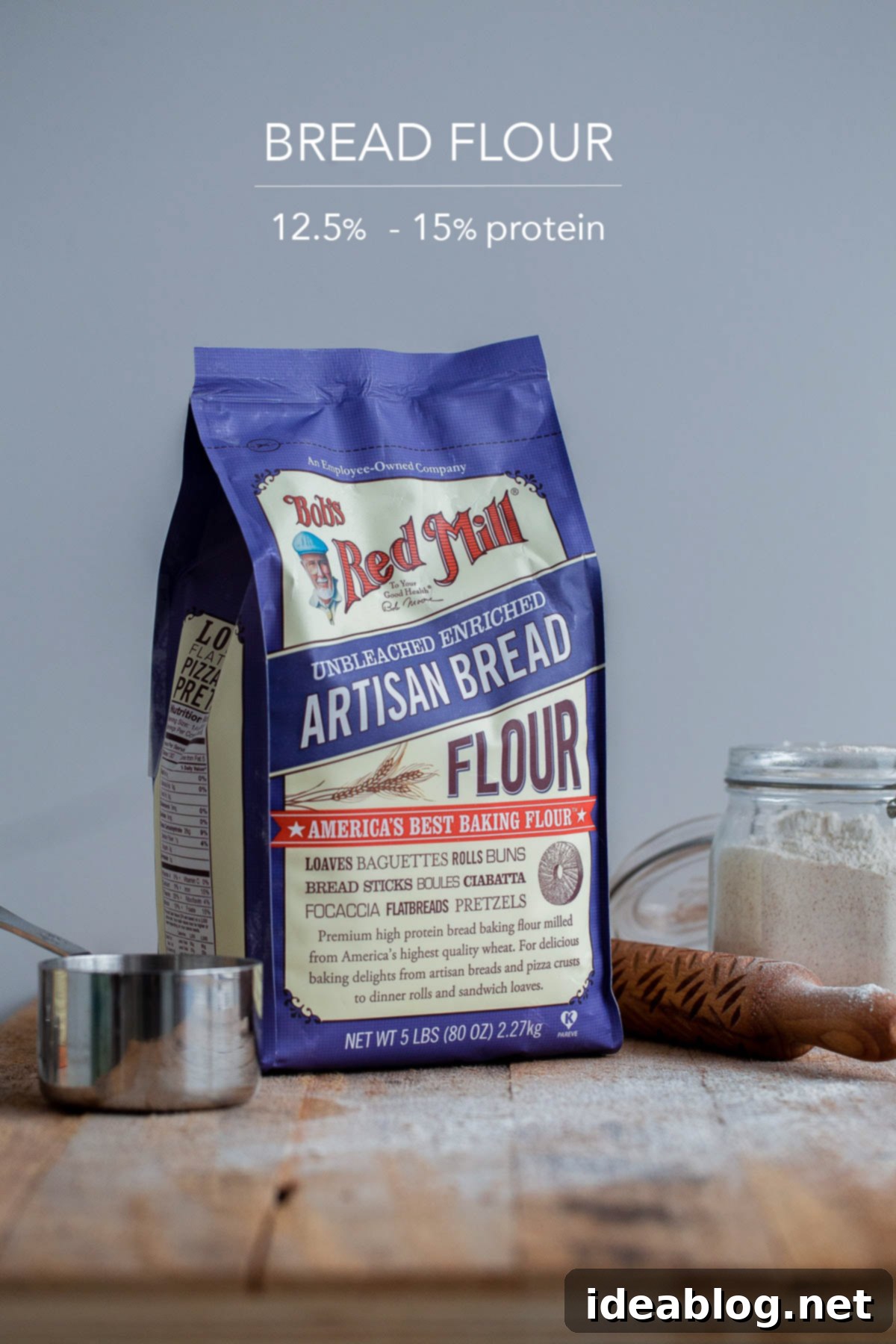
Bread Flour (12.5% – 15% Protein)
As its name clearly indicates, bread flour is specifically formulated for baking robust, airy, and chewy breads. It is milled from hard red spring wheat, a variety naturally rich in protein, which is significantly higher than the hard red winter wheat typically used for all-purpose flour. Like all-purpose flour, bread flour is a refined product, meaning the bran and germ are removed, allowing the high-protein endosperm to fully contribute to gluten development without interference.
The substantially higher protein content in bread flour facilitates greater and more vigorous gluten development when hydrated and kneaded. This robust gluten network is absolutely critical because it allows doughs to stretch considerably and effectively trap large volumes of carbon dioxide gas produced by yeast. The result is impressive oven spring, tall-rising loaves, and the coveted open, chewy crumb structure often admired in artisanal breads. This enhanced gluten also contributes to a satisfying chewiness—a characteristic so desirable that durum wheat, exceptionally high in protein, is the preferred choice for most commercial pasta production. Some cookie recipes even intelligently incorporate a portion of bread flour alongside all-purpose flour specifically to achieve a chewier texture.
Bread flour is the optimal choice for any baked good requiring superior elasticity, strength, and structural integrity. This includes a broad spectrum of yeast-leavened products such as artisan loaves, sandwich breads, bagels, sturdy pizza doughs, and even specialized laminated pastry doughs like puff pastry and strudel, where a strong, extensible dough is paramount for creating distinct, flaky layers. Its high protein ensures that these items can develop the necessary framework to hold their shape and achieve excellent volume.
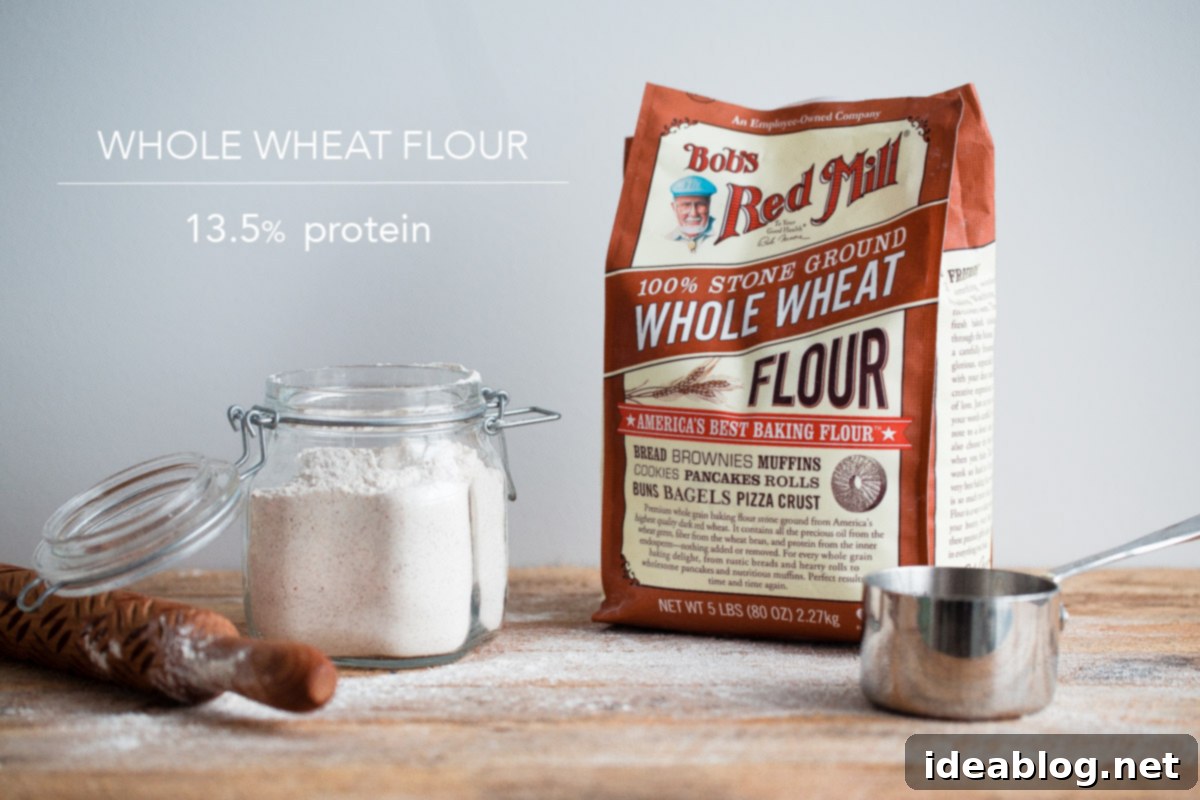
100% Whole Wheat Flour (13.5% Protein)
In contrast to refined flours, true 100% whole wheat flour is produced by milling the entire wheat kernel—germ, bran, and endosperm—typically from hard red wheat varieties. This means it is a truly “whole grain” flour, retaining all the nutritional richness of the original grain. The inclusion of the bran and germ gives whole wheat flour its characteristic darker, often brownish, color, a more pronounced nutty and earthy flavor profile, and a significantly superior nutritional content, brimming with fiber, vitamins, and minerals. This is particularly evident in stone-ground whole wheat flours, which preserve even more of the kernel’s beneficial integrity and flavor complexity.
Despite its generally higher protein content compared to all-purpose flour, the presence of the bran and germ in whole wheat flour poses a unique challenge for gluten development. The sharp, abrasive particles of the bran can physically interfere with and literally “cut” the delicate gluten strands as they attempt to form a cohesive network. This inherent disruption makes it more difficult for a strong, elastic gluten network to fully develop, even with extensive kneading. This fundamental weakening of the gluten structure is precisely why 100% whole wheat breads and other baked goods often tend to have a denser, more compact texture with less overall rise and a tighter crumb compared to products made with refined flours. Achieving a light, open texture with pure whole wheat flour typically requires specific adjustments in hydration and fermentation techniques.
Another crucial consideration when baking with whole wheat flour is its significantly higher liquid absorption capacity. Flours with higher protein content, and especially those that include the fibrous bran and germ, tend to absorb substantially more liquid than lower protein, refined flours. Therefore, if you are substituting whole wheat flour for all-purpose flour in a recipe, it is almost always necessary to increase the liquid amounts to prevent a dry, crumbly, or overly stiff dough. To harness the nutritional benefits and robust flavor of whole wheat without drastically altering the structural integrity of your baked goods, a common strategy is to substitute a small portion (e.g., 25-50%) of the all-purpose flour with an equal quantity of whole wheat flour; this often has minimal impact on the final texture while adding noticeable health benefits and flavor depth.
Optimal Storage of Whole Wheat Flour:
Because whole wheat flour contains the entire wheat kernel, particularly the germ which is rich in natural oils, it is inherently more perishable and has a shorter shelf life than refined flours. These natural oils can become rancid over time, leading to unpleasant off-flavors and odors. To significantly preserve its freshness, nutritional integrity, and prevent spoilage, it is highly recommended to store whole wheat flour in an airtight container in the refrigerator. For extended storage periods (beyond a few weeks), freezing is the best option. This practice helps maintain its quality and prolongs its shelf life, especially if you do not use it on a daily basis.
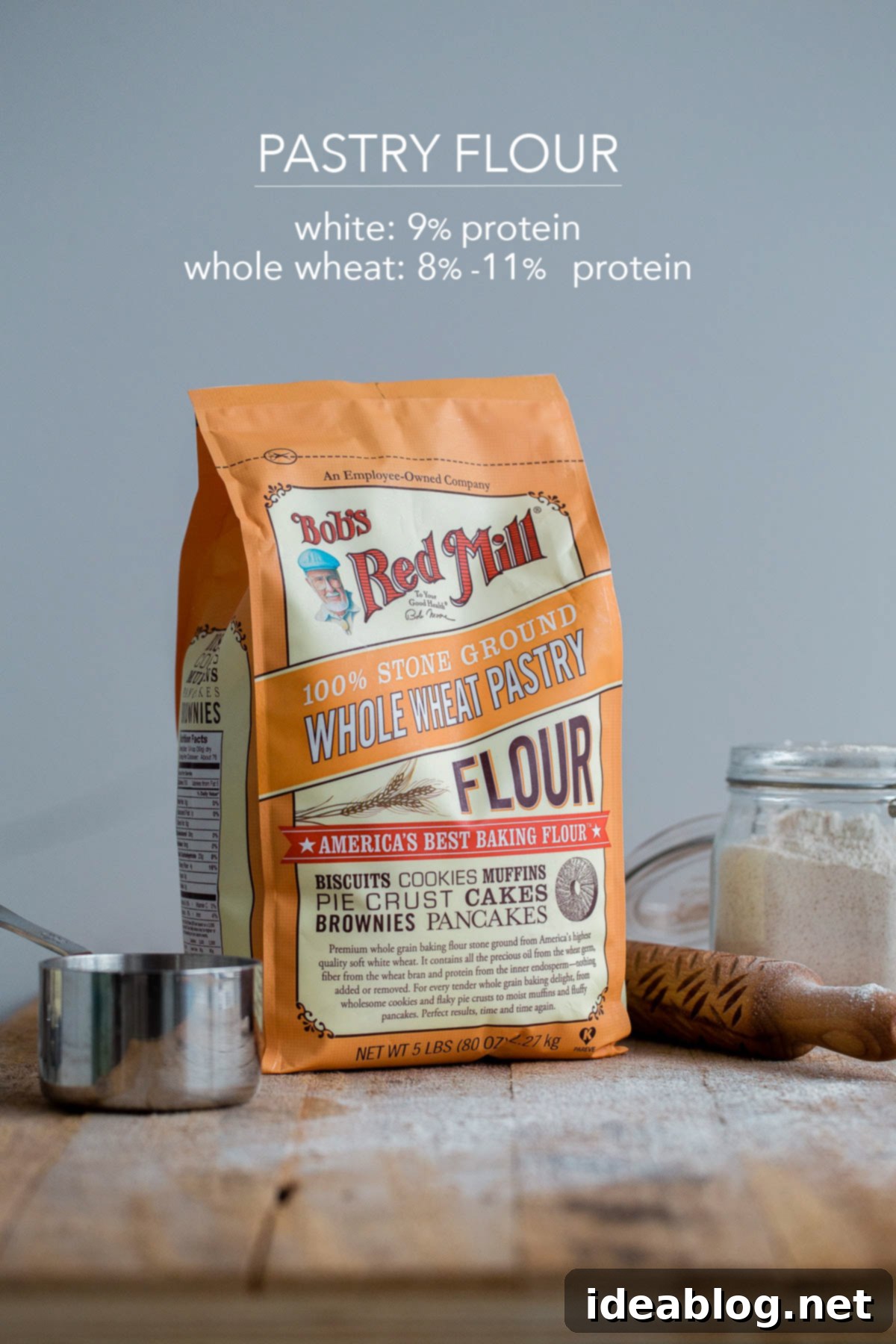
Pastry Flour (8% – 11% Protein)
Pastry flour distinguishes itself from many other common baking flours by its origin: it is primarily milled from soft white wheat. This particular wheat strain is characterized by a significantly lower protein content compared to the red wheat varieties used for all-purpose and bread flours. As a direct consequence, flours derived from soft white wheat are inherently lower in protein and, crucially, produce much less gluten development when hydrated and mixed. This specific characteristic is precisely what makes pastry flour an indispensable ingredient for achieving certain highly desired textures in delicate baked goods.
Minimal gluten development is highly desirable for baked goods where extreme tenderness, a delicate crumb, and a flaky texture are the ultimate goals, rather than elasticity or chewiness. This encompasses a broad range of items, including those typically leavened by baking soda or baking powder, such as tender quick breads, fluffy muffins, delicate cakes, light pancakes, and—most importantly—exceptionally flaky pie crusts and soft biscuits. The low gluten content ensures that these items remain exquisitely tender and crumbly, effectively preventing the toughness that excess gluten development can impart.
Both refined pastry flour (where the germ and bran have been removed), typically around 9% protein, and unbleached refined pastry flour are excellent choices for achieving these tender results. However, for those keen on incorporating whole grains without sacrificing tenderness, whole wheat pastry flour (8% – 11% protein) stands out as an outstanding option. It brilliantly offers the best of both worlds: the full nutritional advantages of whole grains combined with the low-protein characteristics essential for tender baked goods. I frequently substitute it 1:1 for all-purpose flour in recipes such as this poppy seed bread, and the difference in final texture is often imperceptible to even discerning palates. Whole wheat pastry flour truly empowers you to produce light, fluffy, and tender 100% whole grain creations, a feat that would be considerably more challenging to achieve with standard whole wheat flour due to its higher protein and bran content.
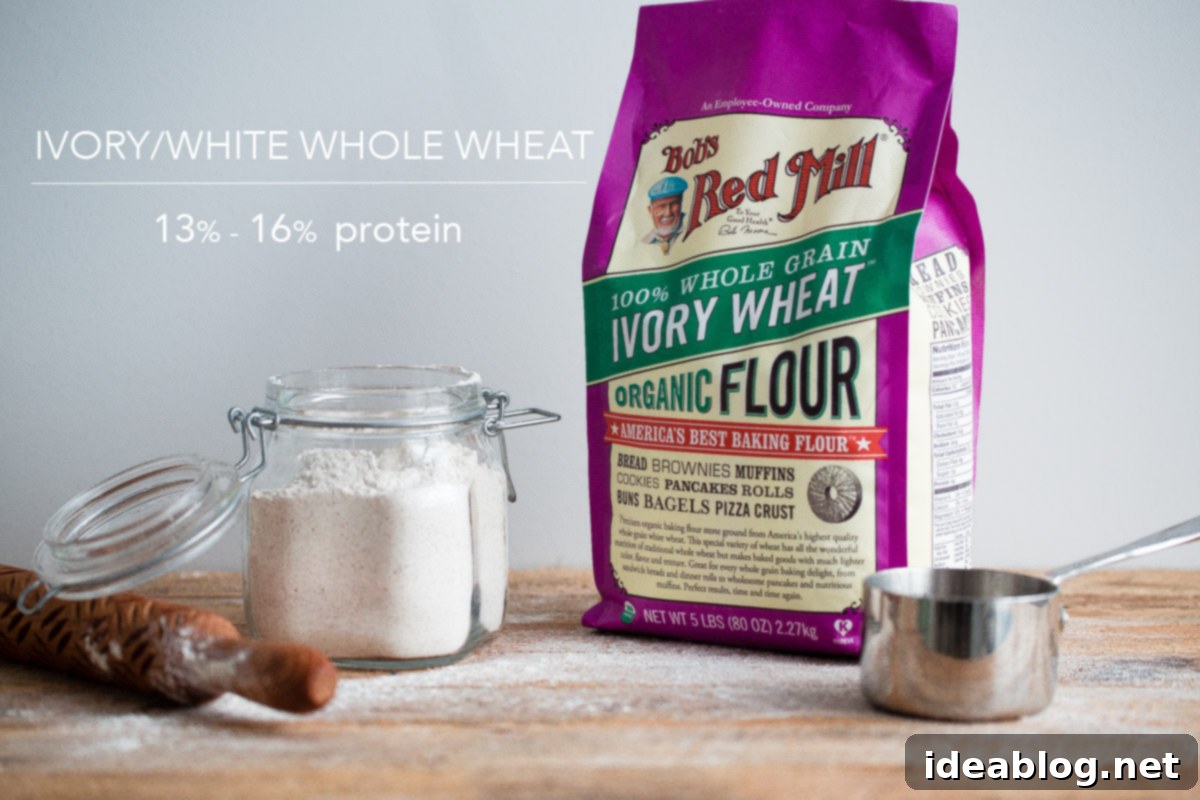
100% White Whole Wheat Flour (13% – 16% Protein)
Relatively newer to the market, white whole wheat flour offers a fascinating and versatile bridge between the comprehensive nutritional benefits of whole grains and the milder flavor and lighter color typically associated with refined white flours. This unique flour is produced from naturally white winter wheat kernels, which, despite their pale appearance, are remarkably high in protein. Bob’s Red Mill’s exceptional version is known as Ivory Whole Wheat Flour, emphasizing its distinctive hue. Interestingly, its protein content can actually be higher than that of traditional hard red whole wheat flour, affording it robust gluten-forming potential similar to bread flour.
Crucially, white whole wheat flour is 100% whole grain, meaning it meticulously includes the bran, germ, and endosperm. However, because it is milled from naturally white wheat kernels, its color is significantly lighter than that of conventional whole wheat flour, making it visually more appealing to some. Beyond its aesthetics, it also presents a sweeter, milder flavor profile, notably lacking the slightly bitter or “wheaty” undertones that some individuals associate with standard whole wheat flour. This makes it an outstanding choice for those who seek the full nutritional advantages of whole grains but prefer a less assertive flavor and a lighter, more delicate crumb in their baked goods. It delivers the exact same comprehensive nutritional benefits as traditional whole wheat flour but with a more universally approachable taste and appearance.
Given its naturally high protein content, white whole wheat flour performs exceptionally well as a whole grain alternative to bread flour. It is ideally suited for baked goods that thrive on increased elasticity and strong gluten development. This includes a wide variety of yeast-leavened doughs, such as wholesome sandwich breads, hearty pizza doughs, chewy bagels, and even delicate laminated doughs like puff pastry and strudel, where its inherent strength can truly shine. Conversely, white/ivory whole wheat flour is less ideal for baked goods where extreme tenderness is the primary objective, such as delicate cakes, muffins, or pastry doughs leavened with baking powder or soda. For these applications, its robust gluten structure might lead to a tougher texture than desired, making a lower-protein flour like pastry flour a more appropriate choice.
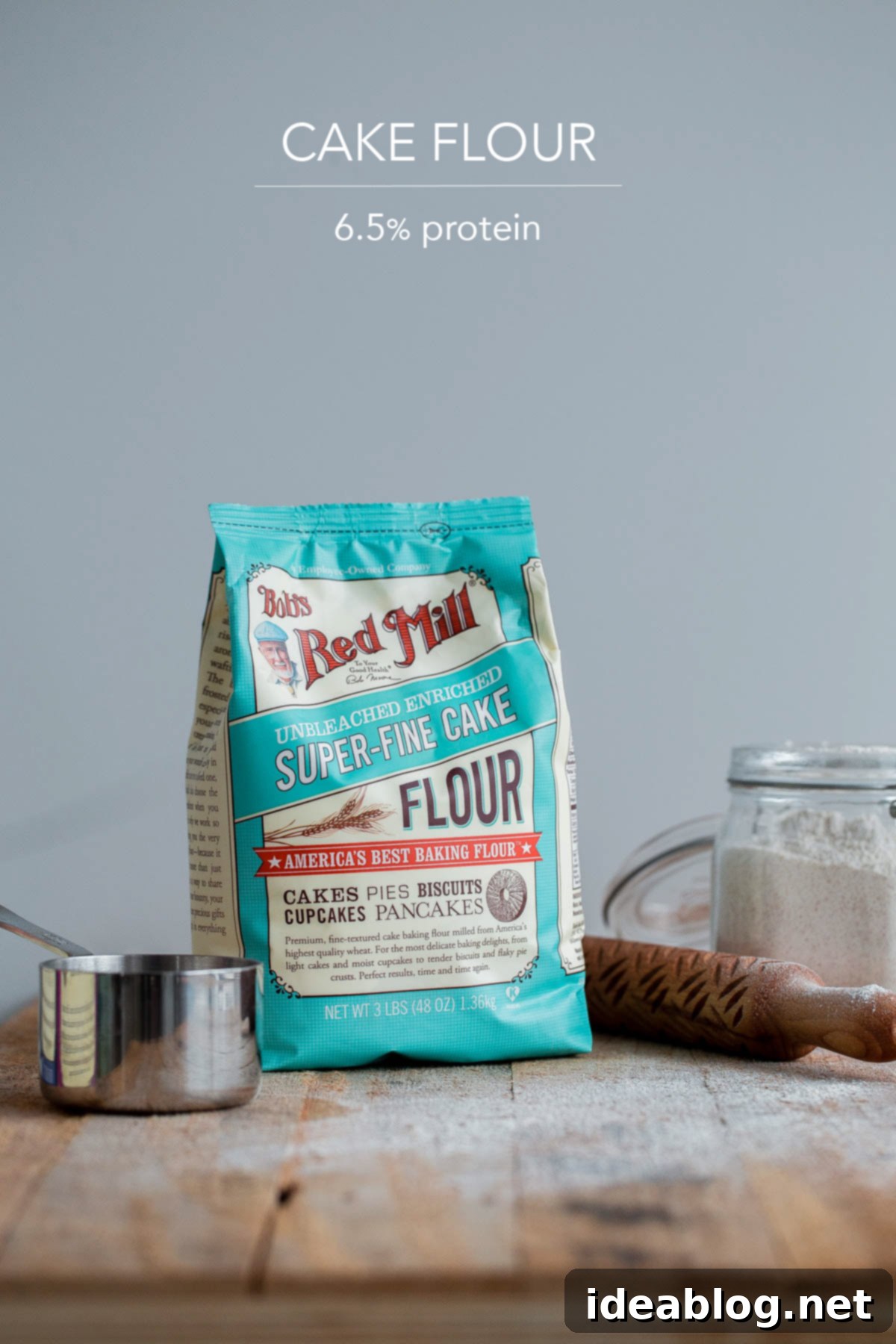
Cake Flour (6.5% Protein)
At the absolute lowest end of the protein spectrum, furthest from bread flour, resides cake flour—the undisputed champion of lightness and supreme tenderness. This highly specialized flour is typically milled from very low-protein wheat strains, sometimes referred to as club wheat. This inherently low protein content means that when cake flour is combined with water, it produces minimal gluten development, resulting in an exceptionally weak gluten network. While this characteristic would be disastrous for achieving the chewy, elastic structure of bread, it is precisely what makes cake flour utterly phenomenal for specific delicate baked goods.
Cake flour is the indispensable secret ingredient behind truly ethereal, light-as-air creations such as delicate angel food cakes, refined genoise sponges, classic sponge cakes, melt-in-your-mouth biscuits, and incredibly tender, fluffy muffins. By understanding the role of gluten, it becomes crystal clear why a flour with a mere 6.5% protein yields vastly different results compared to an all-purpose flour at 12-13% protein; the less gluten development, the more tender, delicate, and fine-crumbed the final product will be. Cake flour ensures that cakes rise beautifully with a soft, cloud-like texture that practically dissolves in your mouth.
Beyond its low protein content, cake flours are also meticulously milled and sifted to an extra-fine, almost powdery texture. This ultra-fine grind significantly increases the surface area of the flour particles, allowing them to absorb liquids very quickly and efficiently. This rapid and uniform absorption, combined with the inherently low protein, contributes profoundly to the signature delicate, tender, and moist crumb that cake flour is celebrated for. It’s important for home bakers to be aware that many generic cake flours available on the market are often chemically bleached (a process that further weakens proteins and brightens the flour) and frequently “cut” with cornstarch. The addition of cornstarch effectively dilutes the protein/gluten content of the flour even further, which is also the underlying principle behind many common DIY cake flour recipes created by combining all-purpose flour and cornstarch.
In stark contrast, Bob’s Red Millcake flour is a premium product distinguished by its natural purity. It is proudly unbleached, contains no harsh chemicals, and is entirely free of cornstarch. This commitment to natural processing means you are getting pure, super-fine, low-protein flour that consistently delivers light-as-air baked goods without any unwanted additives. While I might not reach for cake flour as frequently as all-purpose, its unparalleled ability to transform a simple batter into an extraordinary, delicate, and incredibly tender creation makes it an invaluable, must-have asset in any baker’s pantry for those special occasions demanding ultimate lightness.
Conclusion: Mastering Your Flour, Mastering Your Baking
As we have thoroughly explored, the world of baking flour is far more intricate and nuanced than simply reaching for a bag labeled “flour.” Different types are distinctly not created equal and are rarely truly interchangeable without a deep understanding of the implications for your final product. Each flour possesses a unique protein content, is subjected to a specific milling process, and carries inherent characteristics that dictate its optimal use in baking. Once you grasp these fundamental properties of various wheat flours, you gain an incredible superpower in the kitchen: the ability to experiment with confidence, create your own custom flour blends, and innovate with new recipes that truly reflect your vision. More importantly, this newfound knowledge empowers you to precisely tailor your baked goods to your exact preferences—whether you desire a chewier crust, a lighter, more delicate crumb, a specific flavor profile, or enhanced nutritional value.
No longer will you wonder why your bread failed to rise properly or why your cake turned out unexpectedly tough. You now possess the foundational understanding to intelligently troubleshoot common baking issues, skillfully adapt recipes, and consistently achieve outstanding results. This knowledge transforms baking from a daunting task into an exciting and rewarding science. So go forth, armed with this comprehensive understanding of flour, and let your culinary adventures in baking truly flourish!
If you’re eager to deepen your understanding of culinary science and baking even further, here are some of my favorite trusted resources and books [affiliate links]:
- On Food and Cooking: The Science and Lore of the Kitchen by Harold McGee
- Cookwise: The Hows & Whys of Successful Cooking by Shirley O. Corriher
- The Pie and Pastry Bible by Rose Levy Beranbaum
- The Professional Pastry Chef: Fundamentals of Baking and Pastry by Bo Friberg
- Ratio: The Simple Does Behind the Craft of Everyday Baking by Michael Ruhlman
For more essential kitchen insights, guides, and product recommendations, be sure to explore our dedicated kitchen essentials posts here.
